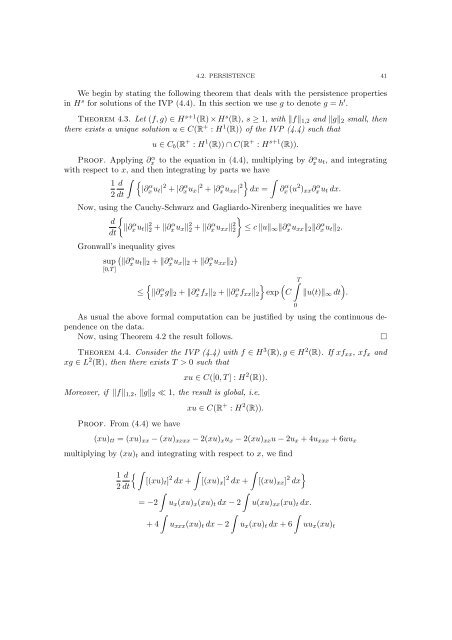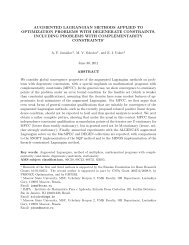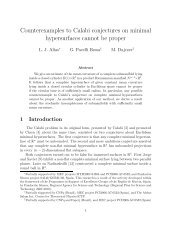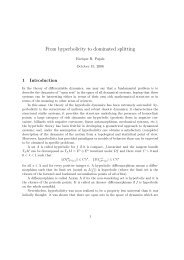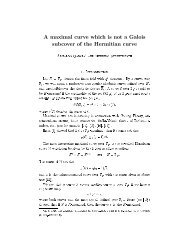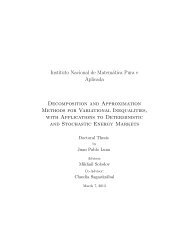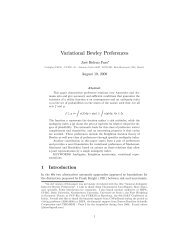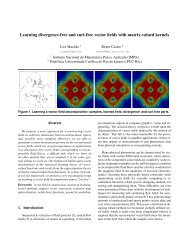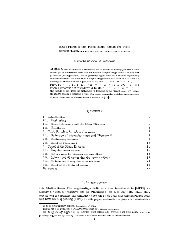Notes on Boussinesq Equation
Notes on Boussinesq Equation
Notes on Boussinesq Equation
You also want an ePaper? Increase the reach of your titles
YUMPU automatically turns print PDFs into web optimized ePapers that Google loves.
4.2. PERSISTENCE 41<br />
We begin by stating the following theorem that deals with the persistence properties<br />
in H s for soluti<strong>on</strong>s of the IVP (4.4). In this secti<strong>on</strong> we use g to denote g = h ′ .<br />
Theorem 4.3. Let (f, g) ∈ H s+1 (R) × H s (R), s ≥ 1, with ‖f‖ 1,2 and ‖g‖ 2 small, then<br />
there exists a unique soluti<strong>on</strong> u ∈ C(R + : H 1 (R)) of the IVP (4.4) such that<br />
u ∈ C b (R + : H 1 (R)) ∩ C(R + : H s+1 (R)).<br />
Proof. Applying ∂x<br />
α to the equati<strong>on</strong> in (4.4), multiplying by ∂x α u t , and integrating<br />
with respect to x, and then integrating by parts we have<br />
∫<br />
1 d {<br />
|∂x α u t | 2 + |∂x α u x | 2 + |∂x α u xx | 2} ∫<br />
dx = ∂x α (u 2 ) xx ∂x α u t dx.<br />
2 dt<br />
Now, using the Cauchy-Schwarz and Gagliardo-Nirenberg inequalities we have<br />
{<br />
}<br />
d<br />
‖∂x α u t ‖ 2 2 + ‖∂x α u x ‖ 2 2 + ‖∂x α u xx ‖ 2 2 ≤ c ‖u‖ ∞ ‖∂x α u xx ‖ 2 ‖∂x α u t ‖ 2 .<br />
dt<br />
Gr<strong>on</strong>wall’s inequality gives<br />
(<br />
‖∂<br />
α<br />
x u t ‖ 2 + ‖∂x α u x ‖ 2 + ‖∂x α )<br />
u xx ‖ 2<br />
sup<br />
[0,T ]<br />
≤<br />
} ( ∫ {‖∂ T<br />
x α g‖ 2 + ‖∂x α f x ‖ 2 + ‖∂x α f xx ‖ 2 exp C<br />
0<br />
)<br />
‖u(t)‖ ∞ dt .<br />
As usual the above formal computati<strong>on</strong> can be justified by using the c<strong>on</strong>tinuous dependence<br />
<strong>on</strong> the data.<br />
Now, using Theorem 4.2 the result follows.<br />
□<br />
Theorem 4.4. C<strong>on</strong>sider the IVP (4.4) with f ∈ H 3 (R), g ∈ H 2 (R). If xf xx , xf x and<br />
xg ∈ L 2 (R), then there exists T > 0 such that<br />
xu ∈ C([0, T ] : H 2 (R)).<br />
Moreover, if ‖f‖ 1,2 , ‖g‖ 2 ≪ 1, the result is global, i.e.<br />
Proof. From (4.4) we have<br />
xu ∈ C(R + : H 2 (R)).<br />
(xu) tt = (xu) xx − (xu) xxxx − 2(xu) x u x − 2(xu) xx u − 2u x + 4u xxx + 6uu x<br />
multiplying by (xu) t and integrating with respect to x, we find<br />
1 d<br />
{ ∫ ∫<br />
∫<br />
}<br />
[(xu) t ] 2 dx + [(xu) x ] 2 dx + [(xu) xx ] 2 dx<br />
2 dt<br />
∫<br />
∫<br />
= −2 u x (xu) x (xu) t dx − 2 u(xu) xx (xu) t dx.<br />
∫<br />
∫<br />
∫<br />
+ 4 u xxx (xu) t dx − 2 u x (xu) t dx + 6 uu x (xu) t


